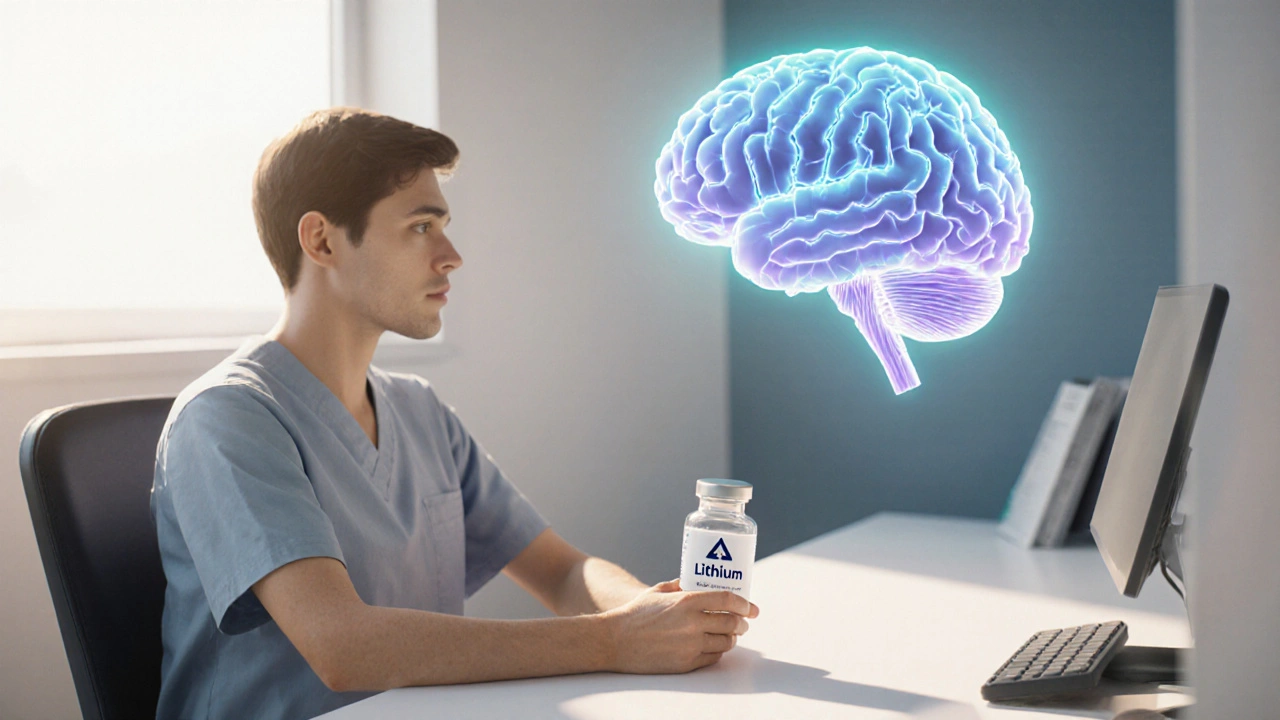Mood Stabilizer Decision Tool
Personalized Treatment Assessment
Answer a few questions about your situation to get tailored recommendations based on clinical guidelines.
When it comes to keeping mood swings in check, Lithium is often the first name that pops up. Lithium is an elemental mood stabilizer that has been used for decades to treat bipolar disorder and severe depression. It works by nudging brain chemistry toward balance, but it isn’t the only player on the field.
Key Takeaways
- Lithium remains the gold‑standard for preventing manic episodes, but it requires regular blood‑level checks.
- Valproate, carbamazepine, and lamotrigine are effective alternatives, each with distinct side‑effect profiles.
- Antipsychotics such as quetiapine can double as mood stabilizers, especially when rapid calming is needed.
- Non‑pharmacologic options-psychotherapy, omega‑3 supplements, and certain antidepressants-can boost medication effects or serve as stand‑alone choices for mild cases.
- Choosing the right regimen hinges on factors like episode type, kidney health, lifestyle, and personal tolerance for monitoring.
How Lithium Works and What to Expect
At its core, Lithium modulates neurotransmitter release, stabilizes neuronal firing, and influences second‑messenger systems such as IP3 and GSK‑3β. The net effect is a smoother mood ride.
Typical dosage starts around 300mg three times a day, titrating up to 900‑1200mg depending on blood levels. Therapeutic range sits between 0.6‑1.2mmol/L; staying inside that window cuts relapse risk by up to 70%.
Onset of action is gradual-most patients feel full benefit after 2‑4weeks, though anti‑manic protection can appear earlier.
Side‑effects that frequently raise eyebrows include mild tremor, increased thirst, and thyroid slowdown. Rare but serious concerns are renal impairment and lithium toxicity, which is why regular serum monitoring (every 3‑6months once stable) is non‑negotiable.
Alternative Mood Stabilizers - A Quick Overview
Not everyone tolerates lithium, and some clinical pictures call for a different approach. Below are the most commonly prescribed alternatives.
Valproate (also called valproic acid) is an anticonvulsant that boosts GABA activity. It’s especially handy for rapid‑cycling bipolar or mixed states.
Carbamazepine works by stabilizing sodium channels and is useful when patients have comorbid seizure disorders.
Lamotrigine excels at preventing depressive relapses, thanks to its glutamate‑modulating properties.
Quetiapine is an atypical antipsychotic that doubles as a mood stabilizer, offering quick calming for acute mania.
Cognitive‑behavioral therapy (CBT) provides structured coping skills, reducing episode severity when paired with medication.
Omega‑3 fatty acids (EPA/DHA) have modest mood‑lifting effects and are safe for most patients.
Selective serotonin reuptake inhibitors (SSRIs) such as sertraline can aid depressive phases but must be balanced against mania risk.
Head‑to‑Head Comparison
| Medication / Option | Primary Mechanism | Typical Dose Range | Onset of Full Effect | Major Side‑Effects | Monitoring Needs | Best Suited For |
|---|---|---|---|---|---|---|
| Lithium | Ion‑based neurotransmitter modulation | 600‑1200mg/day (adjust to serum 0.6‑1.2mmol/L) | 2‑4weeks | Tremor, thirst, thyroid slowdown, renal risk | Serum levels + thyroid & kidney labs | Classic bipolar I, strong anti‑mania |
| Valproate | GABA‑enhancement, sodium channel blockade | 750‑1500mg/day (or 15‑30mg/kg) | 1‑2weeks | Weight gain, liver enzyme rise, teratogenic | Liver function tests, platelets | Rapid‑cycling, mixed episodes, contraindicated in pregnancy |
| Carbamazepine | Sodium channel stabilization | 200‑400mg twice daily | 2‑4weeks | Hyponatremia, rash, leukopenia | Blood counts, liver enzymes | Patients needing seizure protection, those intolerant to lithium |
| Lamotrigine | Glutamate release inhibition | 25‑200mg/day (titrated) | 6‑8weeks | Skin rash (rare Stevens‑Johnson) | No routine labs, watch for rash | Predominant depressive phases, low‑risk mania |
| Quetiapine | Dopamine & serotonin receptor antagonism | 300‑800mg/day | Days to weeks | Sedation, metabolic changes, orthostatic hypotension | Weight, glucose, lipids | Acute mania, mixed states, sleep‑disturbance |
Decision Checklist - Which Option Fits You?
- Episode profile: Frequent manic spikes? Lithium or quetiapine. Predominant depression? Lamotrigine or CBT.
- Kidney & thyroid health: If labs are already borderline, avoid lithium.
- Pregnancy plans: Valproate and carbamazepine carry teratogenic risks; consider lamotrigine or psychotherapy.
- Side‑effect tolerance: Weight gain → quetiapine may be tough; tremor → try valproate.
- Monitoring willingness: If you dislike frequent blood draws, pick an agent with minimal labs (lamotrigine, CBT).
Run through this list with your clinician; the outcome often narrows to two viable choices.
Practical Tips and Common Pitfalls
- Never change lithium dose without checking the serum level first.
- Stay hydrated, especially in hot weather; dehydration spikes lithium concentration.
- When starting valproate, schedule liver function tests at baseline, 1month, then every 6months.
- Lamotrigine must be titrated slowly (25mg/week) to sidestep rash.
- Combine medication with CBT for the best long‑term relapse prevention.
- Omega‑3 supplements are safe but should be taken with meals to improve absorption.
Next Steps
Ready to decide? Book an appointment with a psychiatrist or a specialist mental‑health pharmacist. Bring a list of your current meds, recent labs, and a brief note of your mood‑pattern history. The goal is a collaborative plan that respects both efficacy and your lifestyle.
Frequently Asked Questions
Can I switch from lithium to another mood stabilizer suddenly?
No. Abruptly stopping lithium can trigger rebound mania. Taper the dose while introducing the new drug under medical supervision.
Is lithium safe during pregnancy?
Lithium carries a small risk of cardiac malformations in the first trimester, so many clinicians prefer alternatives like lamotrigine unless the benefits outweigh the risks.
How often do I need blood tests with lithium?
When you’re stable, check serum lithium every 3‑6months. After dose changes, test again within 1‑2weeks.
Can omega‑3 replace medication for bipolar disorder?
Omega‑3 can boost mood stability but isn’t strong enough to replace prescription stabilizers for most patients.
What’s the biggest advantage of lamotrigine over lithium?
Lamotrigine has minimal impact on kidneys and thyroid, and it’s especially good at preventing depressive episodes without causing weight gain.

Brandi Thompson
October 13, 2025 AT 13:30